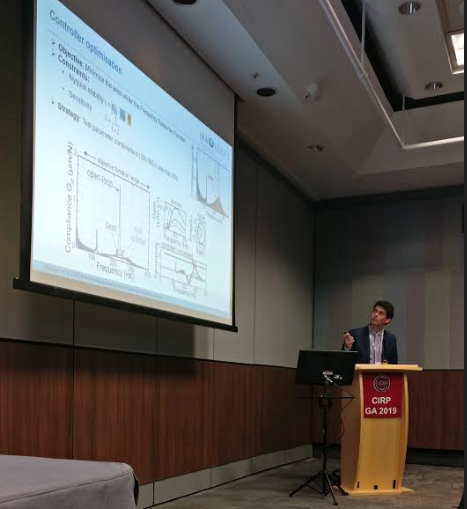Last news about IDEKO.

The research centre has shared its knowledge in the field of vibration suppression at the General Assembly of the CIRP, held last August in the British city.
Ensuring an optimum surface finish is a necessary condition for improving production on today's grinders and milling machines. Researchers at the research centre IDEKO have a long history in this field and have shared the results of their latest research at the General Assembly of the International Academy for Production Engineering (CIRP), held from 18 to 24 August in the English city of Birmingham.
The director of the Dynamics and Control research line of IDEKO, Jokin Muñoa, presented a paper entitled "Analysis of the beating frequencies in dressing and its effect on surface waviness", which focused on the identification of the beating phenomena generated during dressing as the origin of the low-amplitude marks produced in grinding processes.
This work, the result of collaboration between IDEKO's Grinding and Dynamics groups, involved the participation of experts from the research centre David Barrenetxea and Rubén Merino, as well as the lecturer at the Budapest Technical University, Zoltan Dombovari.
The talk served to explain the relationship between the formation of surface wave marks on the ground parts and the vibrations that occur during diamond dressing of the grinding wheel.
"Even very light vibrations can cause surface waviness formation problems, either directly during the grinding process, or indirectly as the topography of the grinding wheel is affected during the diamond dressing process," Muñoa said.
According to the expert, one of the most commonly used tools for dressing grinding wheels are rotary disk dressers. However, their special kinematics and system design facilitates the generation of irregular wheel topographies due to vibratory phenomena as well as to the dresser-wheel kinematic interaction.
For this reason, “it is key to keep rotational speeds away from resonant frequencies and to avoid beating frequencies that can occur between the grinding wheel and the dresser disk”.
The work presented by Muñoa is the first research in which beating during diamond dressing is suggested as the cause of undesirable waviness marks, which is the very reason this work carried out by the IDEKO team becomes especially relevant.
During his presentation, the expert also presented different solutions for the suppression of low frequency marks in these processes and shared real industrial cases, as well as different alternatives to eliminate the generated surface waviness.
Also participating in the event was researcher Xavier Beudaert, who presented a talk on the progress achieved in the CPS4SME project funded by the Basque Government. This initiative focuses on the development of a new portable active damping system based on inertial actuators that significantly increases the limit of vibration stability and suppresses vibrations on large flexible workpieces.
"Productivity in machining operations on flexible workpieces is drastically limited by chatter," Beudaert explained during the talk, held in collaboration with the University of Waterloo.
The concept, patented by IDEKO, consists of an electromagnetic actuator magnetically attached to the workpiece, which is used both to measure the structural response and to actively damp the vibration. At the same time, an autotune algorithm selects the optimal control parameters.